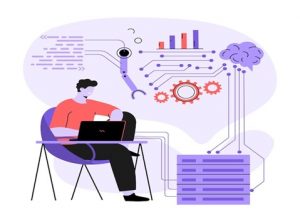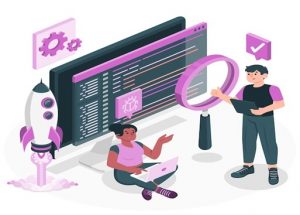

Test automation has been rapidly growing, keeping pace with advancements in technology and the ever-growing complexity of software applications. As we dig into 2024, several emerging trends are composed to shape the landscape of test automation, offering improved efficiency, scalability, and reliability in software testing processes. Let’s explore the top 15 test automation trends expected to dominate the scene this year.

AI and Machine Learning in Test Automation
AI and Machine Learning (ML) are transforming test automation by allowing predictive defect analysis, intelligent test case generation, and adaptive test optimization. AI-driven testing tools can analyse vast amounts of data to identify patterns, predict defects, and optimize test coverage, enhancing the efficiency and accuracy of testing processes. ML procedures continuously learn from testing outcomes, enabling automated test suites to adapt to changing application dynamics. In 2024, the addition of AI and ML technologies into test automation is expected to reorganize testing processes, improve test coverage, and accelerate time-to-market for software products.
Shift-Left Testing
Shift-left testing emphasizes early testing in the software development lifecycle enabling the detection and resolution of defects at the initial stages. By integrating testing into the development process, organizations can reduce costs, and enhance overall product quality. Shift-left testing encourages collaboration between developers and testers, fostering a culture of quality assurance from the outset of the project. By identifying and addressing issues early on, organizations can diminish the risk of defects propagating throughout the development lifecycle, resulting in more strong and reliable software products.

Autonomous Testing
Autonomous testing basically refers to the automation of test activities with minimal human intervention. Through the use of AI, ML, and advanced automation techniques, autonomous testing tools can analyse requirements, generate test cases, execute tests, and analyse results autonomously. This approach helps to reduce manual effort, quickens testing cycles, and improves test coverage. In 2024, autonomous testing is expected to play a crucial role in achieving faster delivery and higher quality in software development projects.
Containerized Testing
Containerization technologies like Docker and Kubernetes are increasingly being adopted for test environments, providing consistency and portability across different stages of the testing process. By these test environments, businesses can achieve greater flexibility, scalability, and efficiency in test performance.
TestOps and DevTestOps
TestOps and DevTestOps practices are becoming mainstream, promoting collaboration between development, testing, and operations teams to streamline processes and quicken delivery without compromising quality. TestOps updates the coordination between development, testing, and operations teams, enabling seamless integration of testing activities throughout the software development lifecycle. DevTestOps extends this concept further by integrating testing into the entire DevOps workflow, from planning and coding to deployment and monitoring.

Low-Code/No-Code Test Automation
Low-code/no-code test automation allows non-technical users to create and execute automated tests without writing complex code. By leveraging spontaneous visual interfaces and pre-built components, individuals with limited programming knowledge can design, deploy, and maintain automated test scripts efficiently. This approach democratizes test automation, enabling business analysts, subject matter experts, and other stakeholders to contribute to testing efforts, thus accelerating test automation adoption and improving collaboration across teams in software development projects.
API and Microservices Testing
API and microservices testing ensure the functionality, reliability, and performance of individual APIs and the interactions between microservices in a distributed architecture. Automated API testing tools confirm endpoints, payloads, and response times, ensuring seamless communication between services. By testing APIs and microservices independently and as part of integrated systems, businesses can identify and address issues early, ensuring the stability and scalability of their applications in production environments.
Progressive Web Apps (PWAs) Testing
This testing confirms the functionality, performance, and user experience of web applications that offer native-like features and functionalities. Testers verify compatibility across different devices and browsers, assess offline capabilities, and evaluate responsiveness and performance under various network conditions. Automated testing tools simulate user interactions, validate service workers, and assess app installation and launch processes. By ensuring the reliability and usability of PWAs, testing facilitates seamless adoption and enhances user satisfaction with web-based applications.
Quantum Computing for Testing
While still in its infancy, Quantum Computing holds the potential to revolutionize test automation by exponentially increasing processing power, enabling faster test execution and complex scenario testing.
Ethical AI Testing
Ethical AI testing confirms AI systems follow to ethical principles and societal norms, preventing unintended biases, discrimination, or harm. Through rigorous testing methodologies and frameworks, organizations evaluate AI algorithms’ fairness, transparency, and accountability. Ethical AI testing aims to build trust and confidence in AI systems, promoting responsible AI deployment and mitigating potential risks to individuals and society.

Robotic Process Automation (RPA) Testing
Robotic Process Automation testing involves validating the functionality, accuracy, and performance of RPA bots that automate repetitive tasks. Testers verify bot behaviour, data handling, and integration with other systems to ensure continuous operations. Automated RPA testing tools simulate user interactions, authorize input-output mappings, and detect anomalies or errors in bot execution. By ensuring the reliability and efficiency of RPA implementations, RPA testing minimizes business disruptions, enhances productivity, and improves the return on investment in automation initiatives.
Security Testing Automation
With the growing threat environment, security testing automation is important for identifying vulnerabilities and ensuring the robustness of applications against cyber threats, including penetration testing and vulnerability scanning. It encompasses techniques such as static analysis, dynamic scanning, and penetration testing to detect and ease security risks efficiently.
Cloud-Based Testing
Cloud-based testing offer scalable, on-demand testing resources and environments accessible via the cloud. These will help test execution, collaboration, and management, reducing infrastructure costs and complexities. By leveraging cloud infrastructure, organizations can achieve greater flexibility, agility, and efficiency in their testing efforts, enabling them to deliver high-quality software products faster and more cost-effectively.
Blockchain Testing
Blockchain testing authorizes the integrity, security, and performance of blockchain-based applications and smart contracts. Testers verify consensus mechanisms, data immutability, and transactional integrity within blockchain networks. Automated blockchain testing tools simulate network conditions, legalize smart contract functionality, and assess blockchain scalability and resilience. By ensuring the reliability and trustworthiness of blockchain solutions, blockchain testing alleviates risks associated with data tampering, unauthorized access, and network vulnerabilities, fostering confidence in blockchain technology for diverse applications across industries.

Quantum-Safe Cryptography Testing
In anticipation of the quantum computing era, quantum-safe cryptography testing is essential for validating cryptographic algorithms resistant to quantum attacks, safeguarding sensitive data in future-proof applications. Testers evaluate the resilience of encryption methods, digital signatures, and key exchange mechanisms against quantum attacks. Automated testing tools simulate quantum computing scenarios and assess cryptographic implementations for vulnerabilities. By proactively testing and certifying quantum-safe cryptography solutions, businesses can lessen the risk of data breaks and maintain the privacy, integrity, and authenticity of sensitive information in the era of quantum computing.
To Conclude
The test automation settings in 2024 is characterized by a convergence of pioneering technologies and best practices, driving efficiency, reliability, and innovation in software testing processes. Embracing these trends enables organizations to stay ahead in a rapidly growing digital ecosystem, delivering high-quality software at speed and scale. As we move forward, proactive adaptation to these trends will be crucial for organizations to maintain a competitive edge and drive success in the software development industry.
As per testinium.com,

Take Your Testing Strategy to the Next Level with BriskWinIT Solutions!
As businesses explore the dynamic landscape of test automation in 2024, partnering with a reliable and innovative service provider like BriskWinIT Solutions can be influential in achieving success. With its proven expertise, and commitment to customer satisfaction, BriskWinIT Solutions stands ready to assist organizations in embracing the latest trends and driving quality at speed and scale. Trust us as your dedicated partner for all of your test automation needs in 2024 and beyond.
So, want to stay ahead in test automation for 2024 and beyond? Explore the top 15 test automation trends in this article and discover how they can develop your testing approach.
Also, we are looking forward to hearing from you! Your participation is crucial in broadening our comprehension of Test Automation services. Your unique perspectives and expertise are highly valued in shaping the future of software testing. Together, let’s advance Test Automation practices and foster innovation in the industry. Join the discussion now and become an integral part of this dynamic community!
Please click here to learn more about us and embark on your journey towards.
Frequently Asked Questions
In this comprehensive guide, we will address some common questions surrounding the latest advancements and emerging trends shaping the settings of test automation. From AI-driven testing to containerized testing, we will discover the key trends that are expected to influence software testing practices in 2024. Whether you are a software developer, tester, or industry enthusiast, this FAQ will provide you valuable insights into the future of test automation and how it can drive innovation and efficiency in software development processes.
What are the key trends driving test automation in 2024?
In 2024, test automation is expected to be driven by advancements in AI and machine learning, the integration of testing into DevOps practices, and the adoption of developing technologies such as blockchain and quantum computing.
How will AI and machine learning impact test automation in 2024?
AI and machine learning will revolutionize test automation by enabling intelligent test case generation, predictive defect analysis, and adaptive test optimization, ultimately enhancing the efficiency and accuracy of testing processes.
What is the significance of Shift-Left Testing?
Shift-Left Testing emphasizes early testing in the software development lifecycle, enabling the detection and resolution of defects at the initial stages, reducing costs, and enhancing overall product quality.
How does TestOps contribute to test automation?
TestOps integrates testing practices into the DevOps pipeline, streamlining collaboration, automation, and continuous feedback loops between development, testing, and operations teams, promoting agility, quality, and efficiency in software delivery processes.
What is Autonomous Testing, and why is it important?
Autonomous Testing involves automating test activities with minimal human intervention, leveraging AI, ML, and advanced automation techniques to hasten testing cycles, improve test coverage, and achieve faster delivery and higher quality in software development projects.
What role does Containerized Testing play?
Containerized Testing involves running test environments, tools, and applications within lightweight, portable containers, facilitating scalability, flexibility, and efficiency in test execution, thus quickening the testing process and improving overall productivity in software development projects.
How does Low-Code/No-Code Test Automation empower users?
Low-Code/No-Code Test Automation empowers non-technical users to create and execute automated tests without writing complex code, democratizing test automation and improving collaboration across teams in software development projects.
Why is API and Microservices Testing significant?
API and Microservices Testing ensures the functionality, reliability, and performance of individual APIs and the interactions between microservices in a distributed architecture, identifying and addressing issues early, ensuring the stability and scalability of applications in production environments.
What is the importance of Ethical AI Testing?
Ethical AI Testing ensures AI systems adhere to ethical principles and societal norms, preventing unintended biases, discrimination, or harm, fostering trust and confidence in AI systems, promoting responsible AI deployment, and mitigating potential risks to individuals and society.
How does Robotic Process Automation Testing benefit organizations in 2024?
RPA Testing involves validating the functionality, accuracy, and performance of RPA bots that automate repetitive tasks, minimizing business disruptions, enhancing productivity, and maximizing the return on investment in automation initiatives.
What role do Cloud-Based Testing Platforms play?
Cloud-Based Testing Platforms offer scalable, on-demand testing resources and environments accessible via the cloud, reshuffling test execution, collaboration, and management, enabling organizations to deliver high-quality software products faster and more cost-effectively.
How does Blockchain Testing ensure the reliability of blockchain solutions?
Blockchain Testing authorizes the integrity, security, and performance of blockchain-based applications and smart contracts, diminishing risks associated with data tampering, unauthorized access, and network vulnerabilities, fostering confidence in blockchain technology for diverse applications across industries.
What are the benefits of Security Testing Automation?
Security Testing Automation legalizes the integrity, security, and performance of software applications and systems, protecting sensitive data, safeguarding against cyber threats, and fostering confidence in the reliability and trustworthiness of software solutions.
How do emerging technologies such as Quantum Computing impact test automation in 2024?
Emerging technologies such as Quantum Computing pose unique challenges and opportunities for test automation, requiring the development of specialized testing methodologies and tools to verify the functionality, performance, and reliability of quantum applications and systems.
How can organizations stay ahead of the curve with these test automation trends in 2024?
Organizations can stay ahead by embracing emerging technologies, fostering a culture of innovation and experimentation, investing in continuous learning and skill development, and collaborating with industry partners and experts to leverage the latest advancements in test automation.